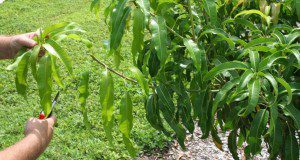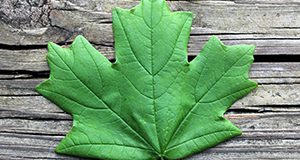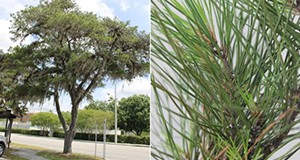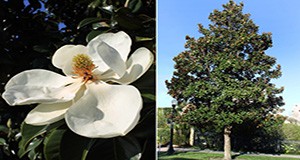This new 6-page document explains the proper way to prune fruit trees using hand tools. An important aspect of growing tropical and subtropical fruit trees is size control through pruning. In addition to size control, pruning also makes it easier to spray the tree and harvest fruit from the tree. Pruning also makes the tree more hardy to wind events and healthier in general because you can remove damaged or unhealthy parts of the tree. Written by Jeff Wasielewski, Jonathan Crane, and Carlos Balerdi, and published by the UF/IFAS Horticultural Sciences Department.
https://edis.ifas.ufl.edu/hs1372
Tag: Landscape Trees
How to Use a Dichotomous Key: A Tutorial Featuring 10 Common Shade Trees of the Tampa Bay Area
A dichotomous key is a tool used to help identify an unknown organism. This twelve-page fact sheet features a key of leaf characteristics for ten common broadleaf trees in the Tampa Bay Area. Accurately navigating this series of paired, either-or choices about leaf characteristics will lead the reader to identify the correct tree from the group of ten. Written by Andrew K. Koeser, Gitta Hasing, Michael G. Andreu, and Melissa H. Friedman and published by the Environmental Horticulture Department.
http://edis.ifas.ufl.edu/ep510
10 Common Palms of the Tampa Bay Area
Palms often serve as key specimens in urban landscape designs. Despite this, their identity is often unknown to Florida’s new, seasonal, and even long-term residents. This ten-page fact sheet serves as a quick reference for some of the most common palms found in North and Central Florida and the Tampa Bay Area in particular. Written by Gitta Hasing, Andrew K. Koeser, Melissa H. Friedman, and Timothy K. Broschat and published by the Environmental Horticulture Department.
http://edis.ifas.ufl.edu/ep506
Ten Common Conifers of the Tampa Bay Area
Conifers are cone-bearing trees often identified by their needles. In addition to their value as landscape trees and lumber and paper sources, they are popular around the holidays as Christmas trees.
This 6-page guide written by Andrew K. Koeser, Holly Finley, Gitta Hasing, Gary W. Knox, and Melissa H. Friedman and published by the Environmental Horticulture Department will assist you in identifying the 10 most common conifers that grow in the Tampa Bay area of Florida. It is an efficient resource for master gardeners, novice tree inventory crews, 4-H forestry teams, and others interested in basic conifer identification.
Ten Common Flowering Trees of the Tampa Bay Area
Blooming trees serve as key focal points in the urban landscape. Florida’s flowering trees can be quite spectacular and leave you wondering, Wow, what tree is that?
This 7-page guide written by Gitta Hasing, Andrew K. Koeser, Gary W. Knox, and Melissa H. Friedman and published by the Environmental Horticulture Department will assist you in identifying the 10 most common flowering trees that grow in the Tampa Bay area of Florida. It is an efficient resource for master gardeners, novice tree inventory crews, 4-H forestry teams, and others interested in basic flowering tree identification.
edis.ifas.ufl.edu/ep505
BOOKSTORE: SP 496 Trees: North & Central Florida ($24.95)
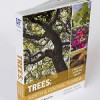 This sturdy, pocket-sized field guide–the only one of its kind for north and central Florida–is designed for landscape professionals, arborists, naturalists, gardeners, and anyone seeking to know the trees around them. Full color photographs of leaves, bark, flowers and full trees, together with clear descriptions and other information make identifying trees easier than ever. The book also features a handy diagnostic key, an introduction to plant parts, a glossary and a ruler to guide you, whether you’re a trained botanist or a total beginner. This field guide to 140 common tree species is written by Andrew Koeser, Gitta Hasing, Melissa Friedman, and Robert Irving and published by UF/IFAS. Available only at the UF/IFAS Extension Bookstore.
This sturdy, pocket-sized field guide–the only one of its kind for north and central Florida–is designed for landscape professionals, arborists, naturalists, gardeners, and anyone seeking to know the trees around them. Full color photographs of leaves, bark, flowers and full trees, together with clear descriptions and other information make identifying trees easier than ever. The book also features a handy diagnostic key, an introduction to plant parts, a glossary and a ruler to guide you, whether you’re a trained botanist or a total beginner. This field guide to 140 common tree species is written by Andrew Koeser, Gitta Hasing, Melissa Friedman, and Robert Irving and published by UF/IFAS. Available only at the UF/IFAS Extension Bookstore.
FOR234/FR296 How to Identify a Tree
FOR234, a 22-page illustrated fact sheet by Michael G. Andreu, Erin M. Givens, and Melissa H. Friedman, guides readers through the process of identifying a tree. Includes references and a tree identification sheet. Published by the UF School of Forest Resources and Conservation, April 2010.
http://edis.ifas.ufl.edu/fr296
